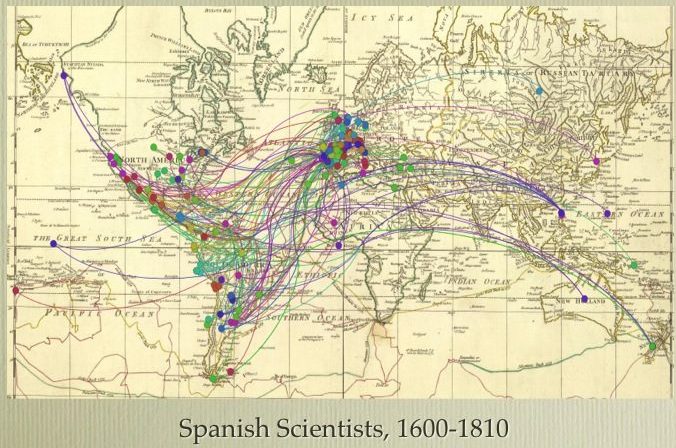
Mapping the Republic of Letters. Stanford University: 2013. <http://republicofletters.stanford.edu/>
Mapping the Republic of Letters is a digital humanities program from Stanford University’s Humanities Center in collaboration with leading international partners. It sheds light on how historical scientific networks contributed to the spread of knowledge from the age of Erasmus to the time of Franklin. Through letters, sociability, and travel this ancient spider’s web was critical to communication and criticism of thought, circulation of people, and commerce of books in the modern era. The site works as an encompassing umbrella gathering a number of selected case studies entailing mainly correspondence together with related projects on the Spanish Empire, the European salons, or the British and Irish who visited Italy in the eighteenth century – Travelers on the Grand Tour.
An introductory video explains one of the chief objectives of the multidisciplinary team. It is indeed the provision of deeper insight into the intellectual profile of a given member of the political body at a particular moment in history. With this aim, the use and development of interactive tools and the creation of a sustainable repository for metadata on early-modern scholarship have been attempted. Visualization and digitization ought to provide with new understandings into the complex life of an irretrievable world. Methodologically, an applied approach to the subject has been adopted from the start, focusing on the above-mentioned case studies – representing complementary strokes of the whole painting. In this respect, it is remarkable that the plan shows common sense and vocation for utility. Readers can gain direct access to datasets and articles in section “Projects and Publications” – adorned with an amazing display of germane pictures! All the information generated is freely available for download and credited use.
Thus, in order to recapture the essence of the Republic of Letters, a growing number of rich monographs has been amassed with the support of prestigious academic groups researching into the topic: Humanities and Bodleian Libraries of Oxford University, the Groupe D’Alembert at the Centre national de la recherche scientifique (CNRS), Politecnico di Milano and the auxiliary project Circulation of Knowledge and Learned Practices in the 17th-Century Dutch Republic. These case studies have been chosen based on geographic range and timeframe, intersecting in a global perspective of the learned network. Nearly the entire set of pieces deals with different challenges and goals concerning qualitative and quantitative data handling and information processing. Given that correspondences formed the erudite republic, deploying avenues for the exchange of ideas and materials, the case studies are mostly concentrated into the mapping of letters written by prominent figures, such as Algarotti, Condorcet, D’Alembert, Voltaire, Locke, Kircher, Galileo and Franklin.
The archive incorporates also An Intellectual Map of Science in the Spanish Empire, 1600-1810, a prosopographical study to grasp larger trends in the production and transmission of scientific knowledge in the Spanish Empire. Moreover, the Salons Project outlines the intellectual and social geography of those exceptional places, mainstreamed by famous salonnières, in the period from 1700 to 1914. Beginning with Paris, salons nurtured intellectual and literary exchange between notable authors, politicians, and socialites all across the continent. Important scholarly developments have taken place in recent decades expanding research beyond the traditional canon for the purpose of acknowledging and teaching many fallen women. Even if their contributions have often gone unnoticed, they played significant roles in the emergence of modern science. All the more reason why the attention devoted to salonnières must be judged as appropriate and pertinent – since no more femme fatale is inscribed in the public list of letter writers collated.
Furthermore, an experimental display of Voltaire’s places of publication (1712-1800), whose data are taken from the catalogue of the Bibliothèque Nationale de France (BnF), is still presented to the audience. An inventory of publications, presentations, courses, and workshops is reported, but the relevant links seem to be broken and there is no e-mail address included for questions or comments on the site. Therefore, further proofreading or updating might be needed. On front page, a misprint of illegible characters is largely offset by a wonderful narrative panorama, which regrettably cannot be rotated, enlarged, or manipulated by the user. As for the Grand Tour, the Dictionary of British and Irish Travellers in Italy (1701-1800), resulting from the entries of Sir Brinsley Ford and others at the Paul Mellon Center, adds an unparalleled data-set for circa. 6,000 tourists.
To sum up, Mapping the Republic of Letters is, considering breadth and depth, a valuable free access online platform supplying a useful and usable teaching tool for undergraduate and introductory courses on intellectual history, political thought, philosophy, or connected disciplines and for casually browsing. This far-reaching global initiative renders an accurate, complete, and carefully delineated survey of this cultural phenomenon in broad terms. Finally, it is most desirable that such an artifact should take on recent developments in digital editorial theory and practice in view to optimize efficiency, top-quality, and democratic participation.
Ramón Bárcena
Universidad de Cantabria

